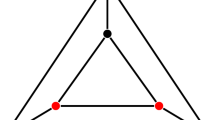Abstract
Zellini (1979, Theorem 3.1) has shown how to decompose an arbitrary symmetric matrix of ordern ×n as a linear combination of 1/2n(n+1) fixed rank one matrices, thus constructing an explicit tensor basis for the set of symmetricn ×n matrices. Zellini's decomposition is based on properties of persymmetric matrices. In the present paper, a simplified tensor basis is given, by showing that a symmetric matrix can also be decomposed in terms of 1/2n(n+1) fixed binary matrices of rank one. The decomposition implies that ann ×n ×p array consisting ofp symmetricn ×n slabs has maximal rank 1/2n(n+1). Likewise, an unconstrained INDSCAL (symmetric CANDECOMP/PARAFAC) decomposition of such an array will yield a perfect fit in 1/2n(n+1) dimensions. When the fitting only pertains to the off-diagonal elements of the symmetric matrices, as is the case in a version of PARAFAC where communalities are involved, the maximal number of dimensions can be further reduced to 1/2n(n−1). However, when the saliences in INDSCAL are constrained to be nonnegative, the tensor basis result does not apply. In fact, it is shown that in this case the number of dimensions needed can be as large asp, the number of matrices analyzed.
Similar content being viewed by others
References
Atkinson, M. D., & Stevens, N. M. (1979). On the multiplicative complexity of a family of bilinear forms.Linear Algebra and its Applications, 27, 1–8.
Carroll, J. D., & Chang, J. J. (1970). Analysis of individual differences in multidimensional scaling via an n-way generalization of “Eckart-Young” decomposition.Psychometrika, 35, 283–319.
Franc, A. (1992).Étude algébrique des Multitableaux: Apports de l'Algèbre Tensorielle [Algebraic study of multiway tables: Contributions from tensor algebra]. Unpublished doctoral dissertation, University of Montpellier II.
Harshman, R. A. (1970).Foundations of the PARAFAC procedure: Models and conditions for an “explanatory” multi-modal factor analysis (UCLA Working Papers in Phonetics, 16:1–84). Los Angeles: University of California at Los Angeles.
Harshman, R. A. (1972).Determination and proof of minimum uniqueness conditions for PARAFAC1 (UCLA Working Papers in Phonetics, 22:111–117). Los Angeles: University of California at Los Angeles.
Kruskal, J. B. (1989). Rank, decomposition, and uniqueness for 3-way andN-way arrays. In R. Coppi & S. Bolasco, (Eds.);Multiway data analysis. Amsterdam: North-Holland.
ten Berge, J. M. F., Kiers, H. A. L. & Krijnen, W. P. (1993). Computational solutions for the problem of negative saliences and nonsymmetry in INDSCAL.Journal of Classification, 10, 115–124.
Zellini, P. (1979). On the optimal computation of a set of symmetric and persymmetric bilinear forms.Linear Algebra and its Applications, 23, 101–119.
Author information
Authors and Affiliations
Rights and permissions
About this article
Cite this article
Rocci, R., ten Berge, J.M.F. A simplification of a result by zellini on the maximal rank of symmetric three-way arrays. Psychometrika 59, 377–380 (1994). https://doi.org/10.1007/BF02296130
Received:
Revised:
Issue Date:
DOI: https://doi.org/10.1007/BF02296130




